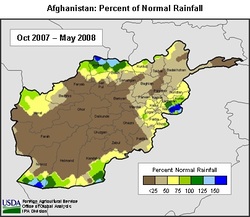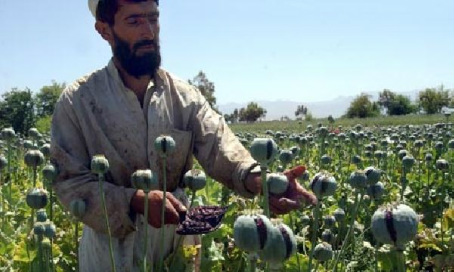By Lupan Oswald
Agriculture in Afghanistan
Agriculture use to drive the Afghan economy, making
up to 50 percent of the GDP before 1979. 1979 is when the Soviet invasion
happened. Before the invasion, the agriculture never produced at full
capability, only 30 percent of the 15 million acres of arable land was
cultivated and farmed. During the invasion Soviet troops planted land mines
everywhere rendering much of the land useless and many people as refugees. After
the invasion, Kabul University did a report that fond that Afghan's agricultural
output was 45 percent less than the 1978 level. The year of 2000, Afgahnistan
experienced its worst food crisis ever recorded due to a severe drought.
up to 50 percent of the GDP before 1979. 1979 is when the Soviet invasion
happened. Before the invasion, the agriculture never produced at full
capability, only 30 percent of the 15 million acres of arable land was
cultivated and farmed. During the invasion Soviet troops planted land mines
everywhere rendering much of the land useless and many people as refugees. After
the invasion, Kabul University did a report that fond that Afghan's agricultural
output was 45 percent less than the 1978 level. The year of 2000, Afgahnistan
experienced its worst food crisis ever recorded due to a severe drought.
Drought

Well-below normal rainfall and winter snowfall across the majority of
Afghanistan during late 2007 and early 2008 have led to the worst drought
conditions in the past 10 years. Widespread losses of rainfed wheat crops have been observed by international non-governmental organization officials across the country’s important northern and western growing regions, while the government of Afghanistan has also reported that irrigated crop yields have fallen significantly this year. Over 80 percent of the nation’s annual precipitation falls as snow in the
predominant mountain ranges of central Afghanistan. The Hindu Kush Mountains, therefore, are the storehouse for much of the country’s water supply, including the majority of its irrigation reserves. Winter snowfall in Afghanistan is an extremely important resource for agriculture throughout the country, as it underpins the viability of much of the nation’s irrigated crops and therefore the stability of its grain production prospects (Sean, 2008).
Afghanistan during late 2007 and early 2008 have led to the worst drought
conditions in the past 10 years. Widespread losses of rainfed wheat crops have been observed by international non-governmental organization officials across the country’s important northern and western growing regions, while the government of Afghanistan has also reported that irrigated crop yields have fallen significantly this year. Over 80 percent of the nation’s annual precipitation falls as snow in the
predominant mountain ranges of central Afghanistan. The Hindu Kush Mountains, therefore, are the storehouse for much of the country’s water supply, including the majority of its irrigation reserves. Winter snowfall in Afghanistan is an extremely important resource for agriculture throughout the country, as it underpins the viability of much of the nation’s irrigated crops and therefore the stability of its grain production prospects (Sean, 2008).
Cash Crop.
Afghanistan in 2000 was the world's largest producer of opium, used to
produce the drug heroin. The total opium production for 1998 was
estimated at 2,102 metric tons against a total of 2,804 metric tons in
1997. This reduction in the level of poppy production was due to heavy
and continuous rains and hailstorms in some of the major poppy producing
provinces. However, in 1999, the country produced a staggering 4,600
metric tons. The rotting economy forced farmers to grow the opium poppies as a cash crop, and this practice was
supported by the Taliban until 2001, because it provided farmers with
money that they would otherwise not be able to earn. However, in 2001,
the Taliban ordered the country's farmers to stop growing poppies
following an edict by Mullah Omar, the supreme religious leader, that
opium cultivation is not permitted under Islam.
produce the drug heroin. The total opium production for 1998 was
estimated at 2,102 metric tons against a total of 2,804 metric tons in
1997. This reduction in the level of poppy production was due to heavy
and continuous rains and hailstorms in some of the major poppy producing
provinces. However, in 1999, the country produced a staggering 4,600
metric tons. The rotting economy forced farmers to grow the opium poppies as a cash crop, and this practice was
supported by the Taliban until 2001, because it provided farmers with
money that they would otherwise not be able to earn. However, in 2001,
the Taliban ordered the country's farmers to stop growing poppies
following an edict by Mullah Omar, the supreme religious leader, that
opium cultivation is not permitted under Islam.
Rebuilding Afghanistans Agriculture Video
Sources
1Advameg. (2011). Afghanistan - agriculture . Retrieved from
http://www.nationsencyclopedia.com/economies/Asia-and-the-Pacific/Afghanistan-AGRICULTURE.html
2.Kelly, A. (2003, April). Rebuilding
afghanistans agriculture sector. Retrieved from
http://www.adb.org/Documents/Reports/Afghanistan/Agriculture/Rebuilding_Agriculture_Sector_AFG
3.Sean,
M. (2008, August 12). Afghanistan: severe drought causes major decline in
2008/09 wheat production . Retrieved from
http://www.pecad.fas.usda.gov/highlights/2008/08/Afghanistan%20Drought/
1Advameg. (2011). Afghanistan - agriculture . Retrieved from
http://www.nationsencyclopedia.com/economies/Asia-and-the-Pacific/Afghanistan-AGRICULTURE.html
2.Kelly, A. (2003, April). Rebuilding
afghanistans agriculture sector. Retrieved from
http://www.adb.org/Documents/Reports/Afghanistan/Agriculture/Rebuilding_Agriculture_Sector_AFG
3.Sean,
M. (2008, August 12). Afghanistan: severe drought causes major decline in
2008/09 wheat production . Retrieved from
http://www.pecad.fas.usda.gov/highlights/2008/08/Afghanistan%20Drought/

